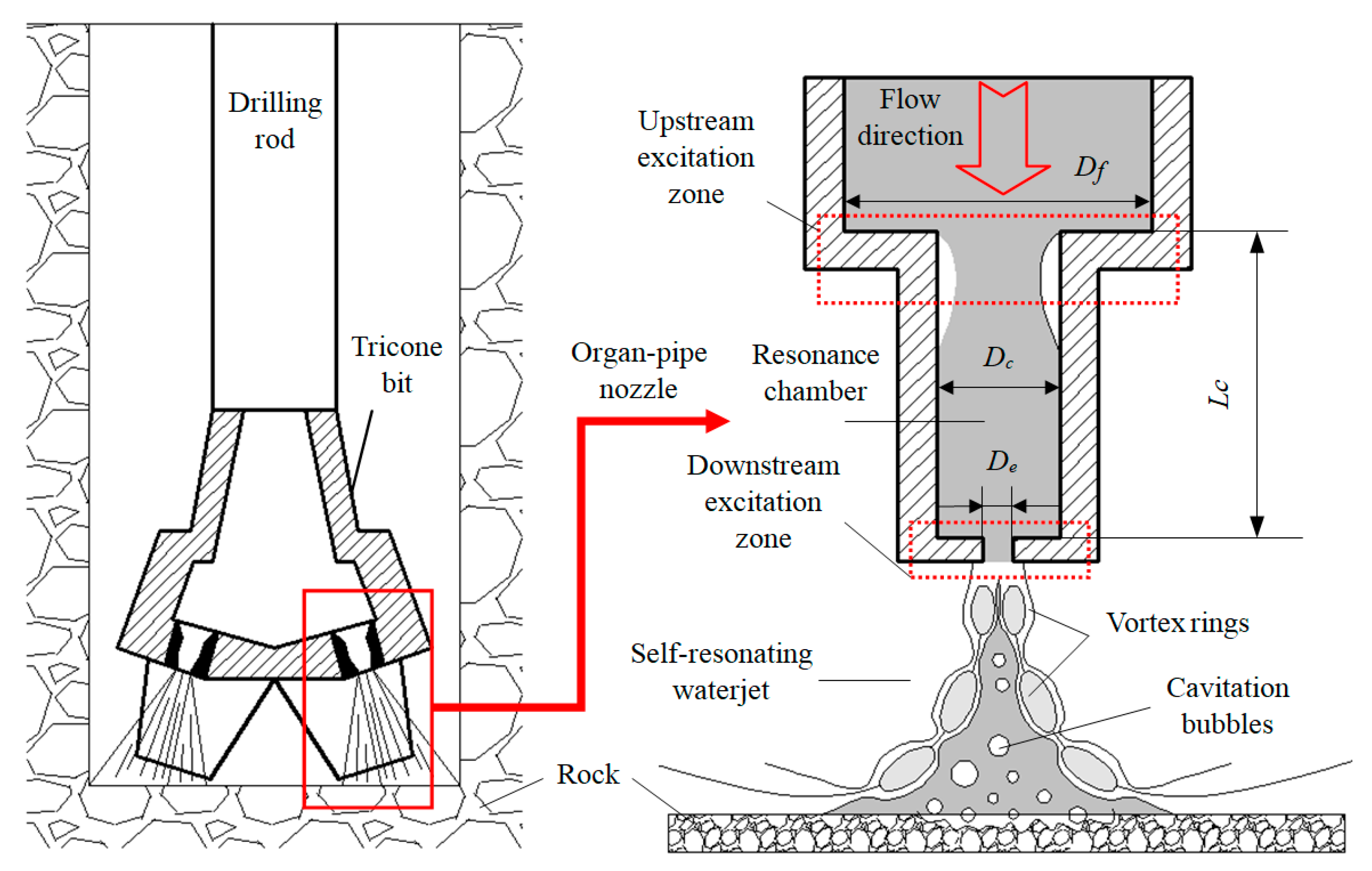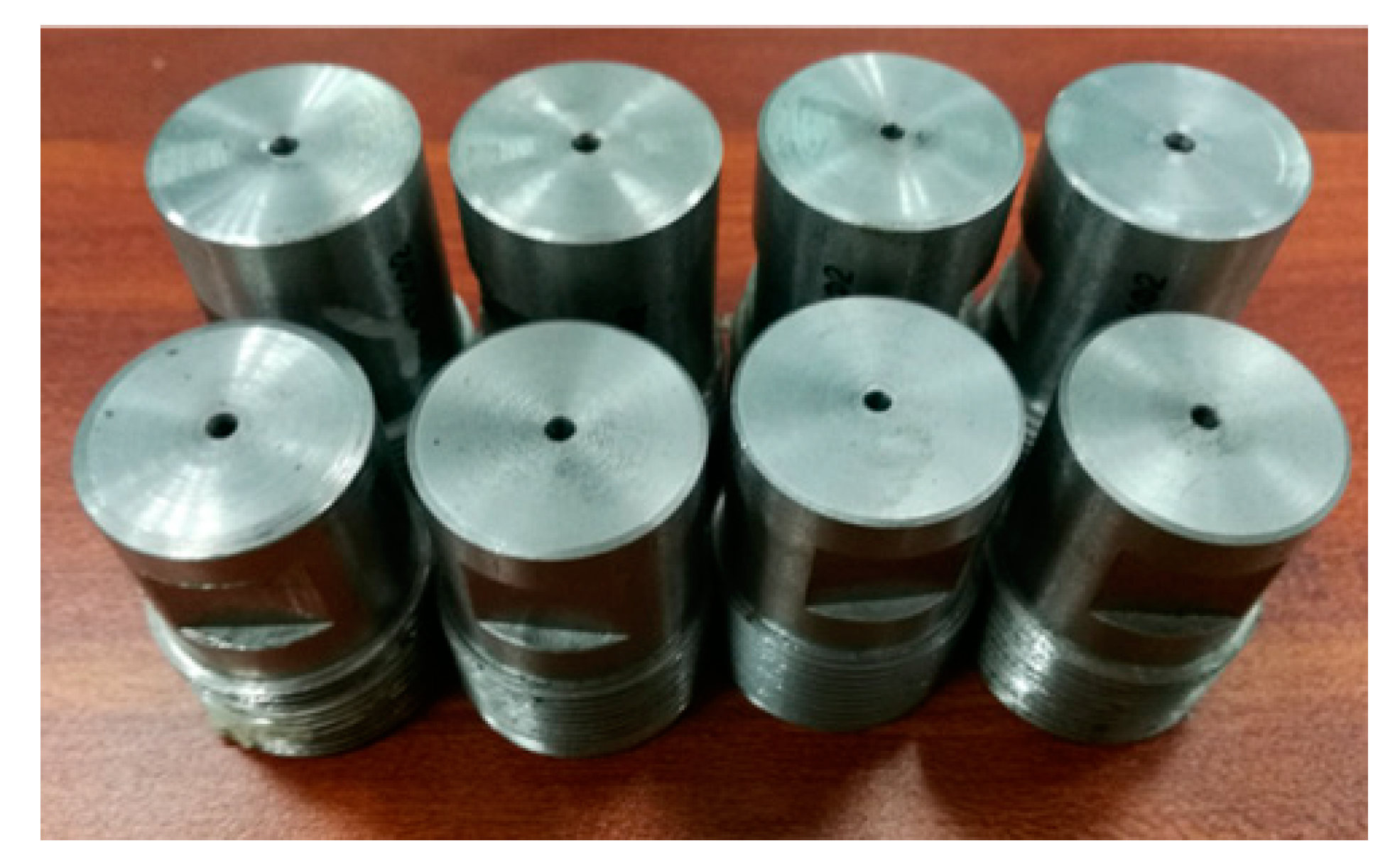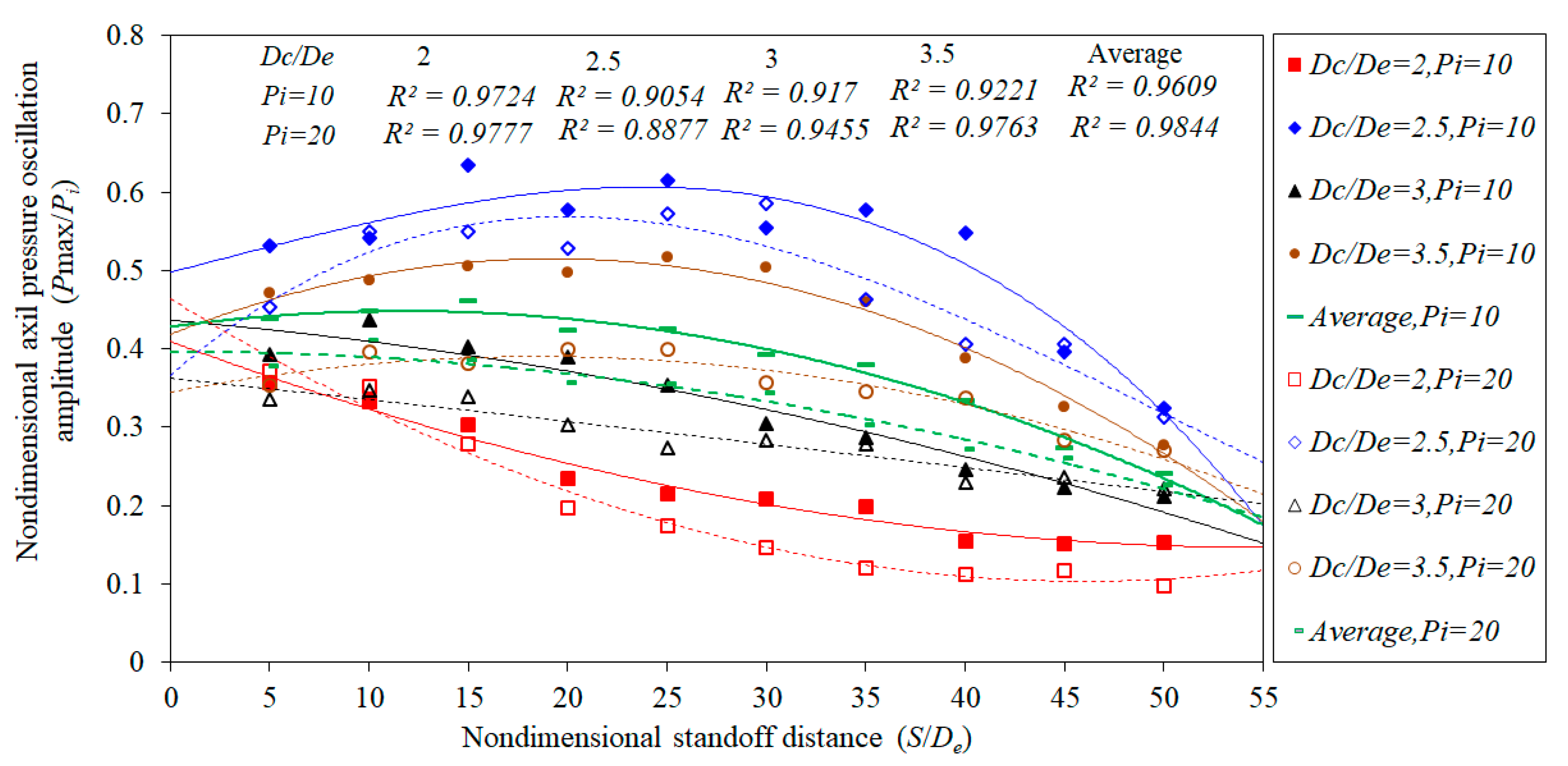The Effects of the Downstream Contraction Ratio of Organ-Pipe Nozzle on the Pressure Oscillations of Self-Resonating Waterjets
Abstract
:1. Introduction
2. SRWJ in Deep-Hole Drilling
3. Experimental Setup and Procedures
4. Results and Discussion
4.1. Axial Pressure Oscillations at an Inlet Pressure of 10 MPa
4.2. Axial Pressure Oscillations at an Inlet Pressure of 20 MPa
4.3. Non-Dimensional Analysis of the Pressure Oscillations
5. Conclusions
Author Contributions
Funding
Acknowledgments
Conflicts of Interest
References
- Li, P.; Zhang, J.S. A New Hybrid Method for China’s Energy Supply Security Forecasting Based on ARIMA and XGBoost. Energies 2018, 11, 29. [Google Scholar] [CrossRef]
- Beraldi, P.; Violi, A.; Bruni, M.E.; Carrozzino, G. A Probabilistically Constrained Approach for the Energy Procurement Problem. Energies 2017, 10, 2179. [Google Scholar] [CrossRef]
- Otsuka, A. Regional Determinants of Energy Efficiency: Residential Energy Demand in Japan. Energies 2018, 11, 14. [Google Scholar] [CrossRef]
- Ranjith, P.; Zhao, J.; Ju, M.; Silva, R.; Rathnaweera, T.; Bandara, A. Opportunities and challenges in deep mining: A brief review. Engineering 2017, 3, 546–551. [Google Scholar] [CrossRef]
- Thomas, C. Stopping Climate Change: The Case for Hydrogen and Coal; Springer: Cham, Switzerland, 2017; pp. 35–40. ISBN 978-3-319-31654-3. [Google Scholar]
- Taherdangkoo, R.; Taherdangkoo, M. Modified stem cells algorithm-based neural network applied to bottom hole circulating pressure in underbalanced drilling. Int. J. Pet. Eng. 2015, 1, 178–188. [Google Scholar] [CrossRef]
- Tatomir, A.; McDermott, C.; Bensabat, J.; Class, H.; Edlmann, K.; Taherdangkoo, R.; Sauter, M. Conceptual model development using a generic Features, Events, and Processes (FEP) database for assessing the potential impact of hydraulic fracturing on groundwater aquifers. Adv. Geosci. 2018, 45, 185–192. [Google Scholar] [CrossRef]
- Maurer, W.; Heilhecker, J.; Love, W. High pressure drilling. J. Pet. Technol. 1973, 255, 851–859. [Google Scholar] [CrossRef]
- Maurer, W. The perfect-cleaning theory of rotary drilling. J. Pet. Technol. 1962, 14, 1270. [Google Scholar] [CrossRef]
- Li, Z. Criteria for jet cavitation and cavitation jet drilling. Int. J. Rock Mech. Min. Sci. 2014, 71, 204–207. [Google Scholar] [CrossRef]
- Conn, A.; Radtke, R. Cavitating bit jets promise faster drilling for deep-hole operations. Oil Gas J. 1977, 75, 129–146. [Google Scholar] [CrossRef]
- Peng, K.; Tian, S.; Li, G.; Alehossein, H. Mapping cavitation impact field in a submerged cavitating jet. Wear 2018, 396, 22–33. [Google Scholar] [CrossRef]
- Conn, A.; Radtke, R. CAVIJET™ augmented deep-hole drilling bits. J. Press. Vessel Technol. 1978, 100, 52–59. [Google Scholar] [CrossRef]
- Conn, A.; Johnson, V.; Liu, H.; Frederick, G. Evaluation of CAVIJET Cavitating Jets for Deep-Hole Rock Cutting; SAND-81-7067, Technical Report; U.S. Department of Energy Office of Scientific and Technical Information: Oak Ridge, TN, USA, 1981. Available online: https://www.osti.gov/biblio/6515979 (accessed on 24 April 2017).
- Johnson, V.; Lindenmuth, W.; Conn, A.; Frederick, G. Feasibility Study of Tuned-Resonator, Pulsating Cavitating Water Jet for Deep-Hole Drilling; SAND-81-7126, Technical Report; Department of Energy Office of Scientific and Technical Information: Oak Ridge, TN, USA, 1981. Available online: https://www.osti.gov/biblio/6266875 (accessed on 24 April 2017).
- Johnson, V.; Chahine, G.; Lindenmuth, W.; Conn, A.; Frederick, G.; Giacchino, G. Cavitating and structured jets for mechanical bits to increase drilling rate—Part I: Theory and concepts. J. Energy Resour. Technol. 1984, 106, 282–288. [Google Scholar] [CrossRef]
- Chahine, G.; Johnson, V. Mechanics and applications of self-resonating cavitating jets. Proc. Int. Symp. Jets Cav. ASME 1985, 15, 21–33. [Google Scholar]
- Li, G.; Zhang, D.; Shen, Z. An experimental study on pressure attenuation of self-resonating cavitation jet under ambient pressure. In Proceedings of the International Symposium on New Applications of Water Jet Technology, Isinomaki, Japan, August 1999. [Google Scholar]
- Li, G.; Shen, Z.; Zhou, C.; Zhang, D.; Chen, H. Investigation and application of self-resonating cavitating water jet in petroleum engineering. Pet. Sci. Technol. 2005, 1, 1–15. [Google Scholar]
- Li, G.; Shi, H.; Liao, H.; Shen, Z.; Niu, J.; Huang, Z.; Luo, H. Hydraulic pulsed cavitating jet-assisted drilling. Pet. Sci. Technol. 2009, 27, 197–207. [Google Scholar] [CrossRef]
- Li, G.; Shi, H.; Niu, J.; Huang, Z.; Tian, S.; Song, X. Hydraulic pulsed cavitating jet assisted deep drilling: An approach to improve rate of penetration. In Proceedings of the International Oil and Gas Conference and Exhibition in China, Beijing, China, 8–10 June 2010. [Google Scholar]
- Fang, Z.; Kang, Y.; Wang, X.; Li, D.; Hu, Y.; Huang, M.; Wang, X. Numerical and experimental investigation on flow field characteristics of organ pipe nozzle. In Proceedings of the IOP Conference Series: Earth and Environmental Science, Montreal, QC, Canada, 22–26 September 2014. [Google Scholar]
- Peng, K.; Tian, S.; Li, G.; Huang, Z.; Yang, R.; Guo, Z. Bubble dynamics characteristics and influencing factors on the cavitation collapse intensity for self-resonating cavitating jets. Pet. Explor. Dev. 2018, 45, 343–350. [Google Scholar] [CrossRef]
- Liu, W.; Kang, Y.; Zhang, M.; Wang, X.; Li, D.; Xie, L. Experimental and theoretical analysis on chamber pressure of a self-resonating cavitation waterjet. Ocean Eng. 2018, 151, 33–45. [Google Scholar] [CrossRef]
- Ding, X.; Kang, Y.; Li, D.; Wang, X.; Zeng, D. Experimental investigation on surface quality processed by self-Excited oscillation pulsed waterjet peening. Materials 2017, 10, 989. [Google Scholar] [CrossRef] [PubMed]
- Li, D.; Li, X.; Kang, Y.; Wang, X.; Long, X.; Wu, S. Experimental investigation on the influence of internal surface roughness of organ pipe nozzle on the characteristics of high pressure jet. J. Mech. Eng. 2015, 51, 169–176. (In Chinese) [Google Scholar] [CrossRef]
- Li, D.; Kang, Y.; Ding, X.; Wang, X.; Fang, Z. Effects of Nozzle Inner Surface Roughness on the Performance of Self-Resonating Cavitating Waterjets under Different Ambient Pressures. Stroj. Vestn. J. Mech. Eng. 2017, 63, 92–102. [Google Scholar] [CrossRef]
- Li, D.; Kang, Y.; Ding, X.; Liu, W. Experimental study on the effects of feeding pipe diameter on the cavitation erosion performance of self-resonating cavitating waterjet. Exp. Therm. Fluid Sci. 2017, 82, 314–325. [Google Scholar] [CrossRef]
- Li, D.; Kang, Y.; Ding, X.; Wang, X.; Fang, Z. An experimental investigation on the pressure characteristics of high speed self-resonating pulsed waterjets influenced by feeding pipe diameter. J. Mech. Sci. Technol. 2016, 30, 4997–5007. [Google Scholar] [CrossRef]
- Li, D.; Kang, Y.; Ding, X.; Wang, X.; Fang, Z. Effects of area discontinuity at nozzle inlet on the characteristics of self-resonating cavitating waterjet. Chin. J. Mech. Eng. 2016, 29, 813–824. [Google Scholar] [CrossRef]
- Li, D.; Kang, Y.; Ding, X.; Liu, W. Effects of the geometry of impinging surface on the pressure oscillations of self-resonating pulsed waterjet. Adv. Mech. Eng. 2017, 9. [Google Scholar] [CrossRef] [Green Version]
- Li, D.; Kang, Y.; Wang, X.; Ding, X.; Fang, Z. Effects of nozzle inner surface roughness on the cavitation erosion characteristics of high speed submerged jets. Exp. Therm. Fluid Sci. 2016, 74, 444–452. [Google Scholar] [CrossRef]
- Li, D.; Kang, Y.; Ding, X.; Wang, X.; Fang, Z. Effects of area discontinuity at nozzle inlet on the characteristics of high speed self-excited oscillation pulsed waterjets. Exp. Therm. Fluid Sci. 2016, 79, 254–265. [Google Scholar] [CrossRef]
- Li, D.; Kang, Y.; Ding, X.; Wang, X.; Liu, W. Effects of feeding pipe diameter on the performance of a jet-driven Helmholtz oscillator generating pulsed waterjets. J. Mech. Sci. Technol. 2017, 31, 1203–1212. [Google Scholar] [CrossRef]
- Li, D.; Chen, Y.; Kang, Y.; Wang, Z.; Wang, X.; Fan, Q.; Yuan, M. Experimental investigation of the preferred Strouhal number used in self-resonating pulsed waterjet. J. Mech. Sci. Technol. 2018, 32, 4223–4229. [Google Scholar] [CrossRef]
- Dehkhoda, S.; Hood, M. An experimental study of surface and sub-surface damage in pulsed water-jet breakage of rocks. Int. J. Rock Mech. Min. Sci. 2013, 63, 138–147. [Google Scholar] [CrossRef]
- Conesa, M.; Pérez, J.S.; Alhama, I.; Alhama, F. On the nondimensionalization of coupled, nonlinear ordinary differential equations. Nonlinear Dynam. 2016, 84, 91–105. [Google Scholar] [CrossRef]






| Made | Parameter | Value |
|---|---|---|
| BD Sensors | Nominal pressure (MPa) | 40 |
| Burst pressure (MPa) | 100 | |
| Accuracy | ≤±0.5% FS | |
| Influence effects of supply (10 V) | 0.05% FS | |
| Influence effects of load (kΩ) | 0.05% | |
| Thermal error (10 K) | ±0.5% FS |
| Made | Parameter | Value |
|---|---|---|
| Measurement SPECIALTIESTM | Nominal pressure (MPa) | 35 |
| Burst pressure (MPa) | 105 | |
| Frequency response (KHz) | 288 | |
| Accuracy | ≤±0.25% FS | |
| Repeatability | ±0.2% | |
| Nonlinearity | ±0.25% |
| Pi (MPa) | Df (mm) | Dc (mm) | De (mm) | Lc (mm) | |||
|---|---|---|---|---|---|---|---|
| 10 | 13 | 2 | 2.5 | 3 | 3.5 | 2 | 21 |
| 20 | 15 | ||||||
© 2018 by the authors. Licensee MDPI, Basel, Switzerland. This article is an open access article distributed under the terms and conditions of the Creative Commons Attribution (CC BY) license (http://creativecommons.org/licenses/by/4.0/).
Share and Cite
Wang, X.; Kang, Y.; Zhang, M.; Yuan, M.; Li, D. The Effects of the Downstream Contraction Ratio of Organ-Pipe Nozzle on the Pressure Oscillations of Self-Resonating Waterjets. Energies 2018, 11, 3137. https://doi.org/10.3390/en11113137
Wang X, Kang Y, Zhang M, Yuan M, Li D. The Effects of the Downstream Contraction Ratio of Organ-Pipe Nozzle on the Pressure Oscillations of Self-Resonating Waterjets. Energies. 2018; 11(11):3137. https://doi.org/10.3390/en11113137
Chicago/Turabian StyleWang, Xiaoliang, Yong Kang, Mengda Zhang, Miao Yuan, and Deng Li. 2018. "The Effects of the Downstream Contraction Ratio of Organ-Pipe Nozzle on the Pressure Oscillations of Self-Resonating Waterjets" Energies 11, no. 11: 3137. https://doi.org/10.3390/en11113137






